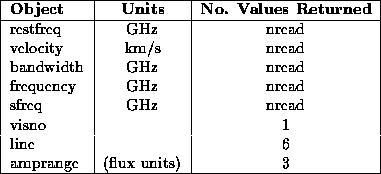




Next: UV Selection --
Up: UV Data Sets
Previous: Selection Steps Performed

Table 2.5: Arguments to UVINFO
The routine uvinfo returns information about the data returned by
the last call to uvread. The argument object is a character
string indicating the information that is desired. The argument data
is a double precision array, containing the returned information.
Possible values for object are:
'restfreq'
- Data contains the rest frequency (GHz) for
each channel returned by uvread.
'velocity'
- Data contains the velocity (km/s) for each
channel returned by uvread.
'frequency'
- Data contains the frequency (GHz) of the
channel returned by uvread, after removing the doppler contribution.
'bandwidth'
- Data contains the bandwidth (GHz) of each
channel returned by uvread.
'sfreq'
- Data contains the sky frequency (GHz) of each
channel returned by uvread.
'visno'
- Data contains a single number, which is the
visibility number (running from 1 upwards) of the last channel read.
'amprange'
- Data contains three values. The first value
indicate the sort of amplitude selection that was requested for this
record, and the second and third values give a flux range.
Possible value of data(1) are -1 (data outside the range [data(2),data(3)]
were rejected), 0 (no amplitude selection was active) or +1 (data inside the
range [data(2),data(3)] were rejected).
For example, consider the following code fragment.
integer maxchan
parameter(maxchan=512)
integer tno,nread
complex data(maxchan)
logical flags(maxchan)
double precision preamble(4),velocity(maxchan)
.
.
.
call uvread(tno,preamble,data,flags,maxchan,nread)
call uvinfo(tno,'velocity',velocity)
After the call to uvinfo will contain the velocity of each channel
read by uvread.





Next: UV Selection --
Up: UV Data Sets
Previous: Selection Steps Performed
Last generated by rsault@atnf.csiro.au on 14 Mar 1996

